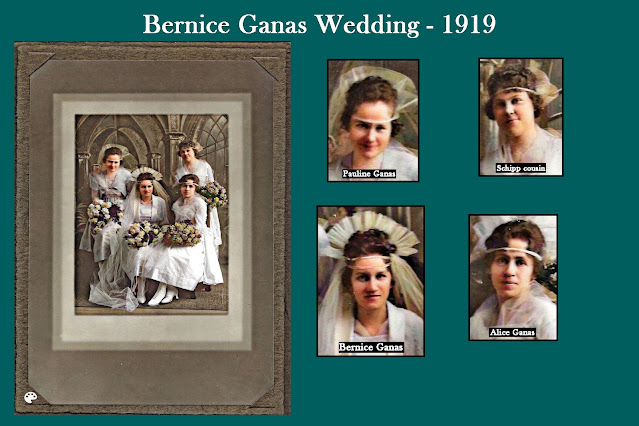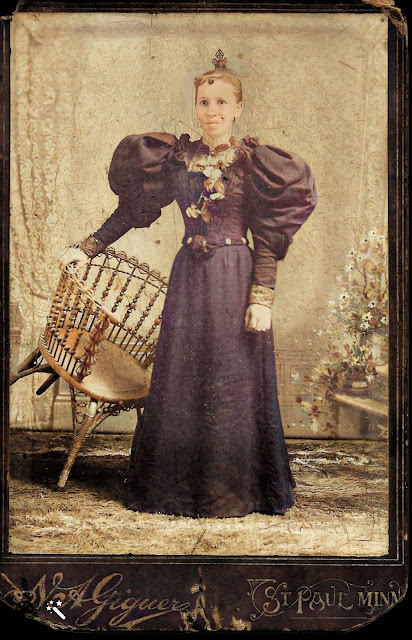It took a
lot of love, courage and optimism to get married in St. Paul, Minnesota in
1936. My parents had all of those attributes.
In the
1930’s St. Paul was a haven for gangsters. As long as they paid off the local
authorities, they could operate untouched in St. Paul as long as they did not
commit their crimes within city limits.
John Dillinger and “Baby Face” Nelson frequented the city along with
Alvin Karpis.
Although
prohibition was repealed in 1933, bootleggers continued their trade for some
years after that.
The Great
Depression was still a major problem in 1936, but was being eased by the New
Deal programs instituted by President Frankin D. Roosevelt.
1936 was a
year of transition for St. Paul. It was recovering from it’s infamous gangster
reputation. New Deal programs were providing some new job opportunities.
In the
beginning
Emily Ganas
and Ambrose Dachtera met in 1st grade in St. Adalbert’s parochial
school. The parishioners were mostly Polish immigrants or their children.
Felician nuns taught in both Polish and English languages. Immigrants knew that
their children needed an education in English to be able to thrive in the U.S.
Ambrose and
Emily were probably looking forward to better times when they married on
September 5, 1936 in St. Adalbert’s Catholic church.

They were
fortunate that they both had jobs. Ambrose worked in a brass factory; Emily
decorated cakes in a large commercial bakery.
There is
little, if any, information about the early years of their marriage. The only
thing of significance is the unfortunate news that there were failed
pregnancies during the first six years.
1942 saw the
birth of their daughter Mary Catherine. After six years, it is safe to say that
they were probably overjoyed.
1942 also
saw the US deeply involved in World War II. Military forces were deployed
around the world. Factories were converted to produce tanks and planes instead
of autos, etc.
Rationing
was in place to ensure equitable distribution of scarce resources,
and gave
priority to the military's needs. Even newborn babies were issued ration books
to ensure that a family’s needs could be met.

Internment
camps were instituted for people of Japanese descent. The 1941 attack on Pearl Harbor had instilled
such fear in the US. There were also internment camps for Germans and Italians
but on a much smaller scale.
Ambrose
entered army service in 1944, but because of his poor eyesight, he was never
sent overseas and instead served at several US installations. He’d made the
rank of Staff Sergeant by the time of his discharge.
Post War
Move
1946: The
war was over. Soldiers were coming home to the US. Corporations and private
employers were required by law to rehire discharged military men who had been
employed by them before the war.
Ambrose
worked at International Harvester before the war. They gave him a job after the
war, but it wasn’t in St. Paul. He was given a job at a factory IH had acquired
in Melrose Park, Illinois – a western suburb of Chicago. With thousands of returning soldiers looking
for work, it was an offer he could not refuse.
So, the
family moved to the village of Northlake, IL just west of Melrose park. It
wasn’t rural or even semi-rural but it was very primitive compared to the
relatively sophisticated urban environment of St. Paul.

The streets
of Northlake were gravel. There was no sewer system – rain and snow runoff was
handled by ditches along each street.
Their house
had a coal furnace and a water heater fired by kerosene. Water came from a well
in the front yard. Waste was collected by a septic tank in the back yard. Emily
tried to make the best of it despite her disappointment.
The good
news was that there was bus service to get to nearby towns that were more
modern and had shopping and entertainment.
One could also ride a bus to the west end of Chicago’s elevated train
system in Oak Park, giving easy access to that great city’s wonders.
Over time,
Ambrose made some interior modifications and improvements. A modern water
heater replaced the original one. The furnace was upgraded to oil and then to
gas.
Northlake
was incorporated as a city. Residential sewer and water lines eliminated the
need for the well and the septic tank.
After a couple of decades, streets were paved and sidewalks installed.
It began to feel much more like civilization.
The 1940’s
ended quietly for the family.
On into
the 1950’s
The 1950’s
saw economic boom times, a baby boom and expansion of urban suburbs. But the
decade also saw the Korean War and increased pressure of the Cold War. There
was the anti-communism hysteria of McCarthyism. Tensions were rising as the
Civil Rights movement began in earnest.Emily gave birth to their first son,
Mark, in 1953. After ten years of family stability, this was a drastic change
in the household. Diapers, baby formula, crib, baby clothes. It was a bit of an upheaval.
\ 
Twenty-two
months later in 1954 another son, David, came into the world. Not as much of a
drastic upheaval, but added significant pressure to the family.
But once the
boys were out of diapers, things settled down a little. Emily went to work.
Ambrose took on a second job. Not easy but they were managing.
Life went
along at a steady pace for number of years. Eventually both Ambrose and Emily
retired. Mary, Mark and David went their separate ways.
Ambrose died
of cancer at the age of 79 in 1993.
Emily died of cancer in 2011 just months before her 99th
birthday.
Since
neither Mark nor David had any children, this branch of the Dachtera family
will go no further. One branch falls off the tree.
}}}}}}}}}}}}}}}}}}}}}}}}}}}}}}}}}}}}}}}}}}}}}}}}}}}}}}}}}}}}}}}}}}}}}}}}}}}}}}}}}}}}}}}}}}}}}}}}}}}}}}}}}













